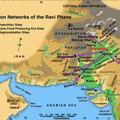The body may have been wrapped in a shroud, and was then placed inside a wooden coffin, which was entombed in a rectangular pit surrounded with burial offerings in pottery vessels.
344 posts, also carried on our Facebook page, about the ancient Indus Valley civilization, including important news, research and occasional visits to museums with ancient Indus artifacts.
Jul 31, 2014
J.M. Kenoyer describes it as a "square seal with animal whose multiple-heads include three important totemic animals: the bull, the unicorn, the antelope. All three animals appear individually on other seals along with script, but this seal has no script.
Jul 29, 2014
The earliest settlement, during Period 1 (c. 3300-2800 BC), was on the west side of Mound AB and NW corner of Mound E. During Period 2 (c. 2800-2600 BC) all of Mounds AB and E came to be occupied, and by the end of Period 3 (c.
Jul 26, 2014
A single bead pot with a private collection of 133 beads from about 1700 BCE found at Harappa in 1996. This amazing find included beads from all phases of Harappan occupation, in carnelian, faience, and even an unknown type of crystalline rock.
See also
Jul 23, 2014
A recreation of an ancient Indus trader using weights to weigh goods (left, by Jonathan Mark Kenoyer), cubical weights in graduated sizes from Allahdino (top right) and Harappa (bottom right). These weights conform to the standard Harappan binary weight system
Jul 20, 2014
At the peak of the Indus Civilization (Period 3, 2600-1900 BCE), the most common dress for female figurines was the belt and/or short skirt usually situated at the same point on the hips as the figurine’s hands, shown in these two terra cotta figurines found
Jul 17, 2014
In color is a seal, in black and white two seals and corresponding sealings made from them (Joshi and Parpola, Corpus of Indus Seals and Inscriptions, Vol. 1, M 306-8).
Mark Kenoyer writes that "discoveries of this motif on seals from Mohenjo-daro definitely
Jul 14, 2014
It is unknown whether elephants were domesticated in the Indus Civilization. However, one of the few elephant figurines from Harappa is a head with large stylized ears and red and white stripes painted across the face.
Jul 10, 2014
Mark Kenoyer writes: "One famous stone vessel found at Mohenjo-daro is a tall glass with concave sides that is similar in shape to ritual columns found in Balochistan and Afghanistan.
Jul 8, 2014
A Kulli plate very similar to ancient Indus plates with two tigers facing each other and motifs similar to those of the Nal culture of Balochistan (see also the related post National Museum of Oriental Art- Tucci). A recent article, Commodities and Things: The
Jul 5, 2014
Dholavira is located on Khadir Beyt, an island in the Great Rann of Kutch in Gujarat State, India. It was excavated between 1990 and 2005 by R.S. Bisht (the field research reports still await publication). In the same size range as Harappa and Mohenjo Daro, it
Jul 3, 2014
A composite tubular gold bead found on Mound AB at Harappa in 2000. Greenish corroded copper-alloy from an interior wire covers part of the gold bead.
Jul 1, 2014
A painted dish of a pedestaled vessel from Harappa found in 1993. The painted design includes two peacocks and a sacred tree. Mark Kenoyer writes: "Painted dish portion from a dish-on-stand.
Jun 28, 2014
Ernest Mackay writes (1938) "As far as we can tell at present, this street appears to be the second most important thoroughfare of the city; for although it is longer than the street that crosses it at right angles, coming presumably from the east gate of the
Jun 26, 2014
Sir Mortimer Wheeler noted that "Harappa has produced a hint of an antecedent culture... " The so-called Ravi Phase, an early phase of Indus culture (c.















